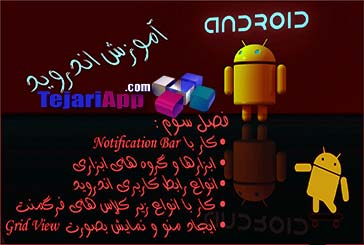آموزش اندروید فصل سوم قسمت چهارم – رابط کاربری

آموزش اندروید فصل سوم قسمت سوم – رابط کاربری
2 تیر 1395


آموزش اندروید فصل سوم قسمت پنجم – RelativeLayout
4 تیر 1395

آموزش برنامه نویسی اندروید فصل سوم
در قسمت بیست و دوم آموزش اندروید به مبحث ابزار های گروهی ادامه داده و با آموزش سه گروه RelativeLayout و FrameLayout و scrollView به مبحث گروه های ابزاری پایان میدهیم و امیدواریم که کارایی لازم را داشته باشد.
آموزش اندروید فصل سوم قسمت چهارم – رابط کاربری
توجه : برای مشاهده تصاویر در سایز اصلی بر روی آنها کلیک کنید.
RelativeLayout
در این گروه میتوانید چینش ابزارهارا بسته به چینش دیگر ابزار موجود تنظیم کنید.
<RelativeLayout xmlns:android="http://schemas.android.com/apk/res/android" xmlns:tools="http://schemas.android.com/tools" android:layout_width="match_parent" android:layout_height="match_parent" tools:context="com.example.testprj.MainActivity" > <TextView android:id="@+id/textView1" android:layout_width="wrap_content" android:layout_height="wrap_content" android:layout_alignParentLeft="true" android:layout_alignParentTop="true" android:layout_marginLeft="90dp" android:layout_marginTop="36dp" android:text="@string/hello_world" /> <Button android:id="@+id/button1" android:layout_width="wrap_content" android:layout_height="wrap_content" android:layout_alignRight="@+id/textView1" android:layout_below="@+id/textView1" android:layout_marginTop="50dp" android:text="Button" /> </RelativeLayout>
ابزاری که در این گروه نمایش داده میشود دارای خصوصیاتی است که محل قرارگیری آن را با دیگر ابزار ها تنظیم میکند.که شامل خصوصیات زیر است
- Layout_alignParentTop :ابزار والد بالا
- Layout_alignParentLeft :ابزار والد چپ
- Layout_alignLeft : ابزار چپ
- Layout_alignRight :ابزار راست
- Layout_below :ابزار پایین
- Layout_centerHorizontal :در صورت true بودن ابزار به صورت افقی در وسط صفحه قرار میگیرد
- layout_centerInParent :در صورت true بودن ابزار به صورت افقی و عمودی در وسط صفحه قرار میگیرد
باید به خصوصیات فوق مقدار ID ابزاری را دهیم که براسا آن ابزار این خصوصیات مقداردهی شوند.
همانگونه که در تصویر زیر مشاهده میکنید میتوانید به صورت گرافیکی نیز محل ابزار هارا براساس ابزار ها دیگر تنظیم کنید
FrameLayout
این نما تنها مناسب برای یک ابزار نمایش است چون در این گروه همه ابزار ها در بالای صفحه و سمت چپ قرار میگیرند و اگر از دو ابزار استفاده کنیم روی یکدیگر قرار گرفته و نمای خوبی نخواهند داشت.به مثال زیر دقت فرمایید
<?xml version="1.0" encoding="utf-8"?> <FrameLayout xmlns:android="http://schemas.android.com/apk/res/android" android:layout_width="match_parent" android:layout_height="match_parent" > <TextView android:id="@+id/textView1" android:layout_width="wrap_content" android:layout_height="wrap_content" android:text="TextView" /> <Button android:id="@+id/button1" android:layout_width="wrap_content" android:layout_height="wrap_content" android:text="Button" /> </FrameLayout>
نتیجه دستورات فوق به صورت زیر خواهد بود
ScrollView
این گروه ابزاری نوعی از FrameLayout است با این تفاوت که اگر ابزارهای موجود در صفحه از فضای اولیه صفحه فراتر رفته باشند میتوان بین آنها Scroll کرد اما از آنجایی که این layout نیز تنها یک عنصر میتواند داشته باشد بنابراین مانند زیر از یک LinearLayout درون آن برای چینش ابزار دلخواه استفاده میکنیم
به مثال زیر دقت کنید
<?xml version="1.0" encoding="utf-8"?> <ScrollView xmlns:android="http://schemas.android.com/apk/res/android" android:layout_width="match_parent" android:layout_height="match_parent" > <LinearLayout android:layout_width="fill_parent" android:layout_height="wrap_content" android:orientation="vertical" > <TextView android:id="@+id/textView1" android:layout_width="fill_parent" android:layout_height="wrap_content" android:text="TEXT 1" /> <TextView android:id="@+id/textView2" android:layout_width="fill_parent" android:layout_height="wrap_content" android:text="TEXT 2" /> <TextView android:id="@+id/textView3" android:layout_width="fill_parent" android:layout_height="1000dp" /> <TextView android:id="@+id/textView4" android:layout_width="fill_parent" android:layout_height="wrap_content" android:text="TEXT 3" /> <TextView android:id="@+id/textView5" android:layout_width="fill_parent" android:layout_height="wrap_content" android:text="TEXT 4" /> <TextView android:id="@+id/textView6" android:layout_width="fill_parent" android:layout_height="wrap_content" android:text="TEXT 5" /> </LinearLayout> </ScrollView>
نتیجه را مطابق شکل زیر خواهید دید







